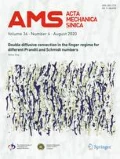Abstract
To understand how a woodpecker is able accelerate its head to such a high velocity in a short amount of time, a multi-rigid-segment model of a woodpecker’s body is established in this study. Based on the skeletal specimen of the woodpecker and several videos of woodpeckers pecking, the parameters of a three-degree-of-freedom system are determined. The high velocity of the head is found to be the result of a whipping effect, which could be affected by muscle torque and tendon stiffness. The mechanism of whipping is analyzed by comparing the response of a hinged rod to that of a rigid rod. Depending on the parameters, the dynamic behavior of a hinged rod is classified into three response modes. Of these, a high free-end velocity could be achieved in mode II. The model is then generalized to a multihinge condition, and the free-end velocity is found to increase with hinge number, which explains the high free-end velocity resulting from whipping. Furthermore, the effects of some other factors, such as damping and mass distribution, on the velocity are also discussed.
Graphical Abstract













Similar content being viewed by others
References
Gibson, L.: Woodpecker pecking: How woodpeckers avoid brain injury. J. Zool. 270, 462–465 (2006)
Wang, L., Cheung, J.T.-M., Pu, F., et al.: Why do woodpeckers resist head impact injury: a biomechanical investigation. PLoS One 6, e26490 (2011)
Yoon, S.-H., Park, S.: A mechanical analysis of woodpecker drumming and its application to shock-absorbing systems. Bioinspiration Biomim. 6, 016003 (2011)
Zhu, Z., Zhang, W., Wu, C.: Energy conversion in woodpecker on successive peckings and its role on anti-shock protection of brain. Sci. China: Technol. Sci. 57, 1269–1275 (2014)
Oda, J., Sakamoto, J., Sakano, K.: Mechanical evaluation of the skeletal structure and tissue of the woodpecker and its shock absorbing system. JSME Int. J., Ser. A. 49, 390–396 (2006)
Vincent, J., Sahinkaya, M., O’Shea, W.: A woodpecker hammer. Proc. Inst. Mech. Eng., Part C. 221, 1141–1147 (2007)
McNeill Alexander, R.: Tendon elasticity and muscle function. Comp. Biochem. Physiol., Part A: Mol. Integr. Physiol. 133, 1001–1011 (2002)
Bennet-Clark, H., Lucey, E.: The jump of the flea: a study of the energetics and a model of the mechanism. J. Exp. Biol. 47, 59–76 (1967)
Kelley, D.E., Slasky, B.S., Janosky, J.: Skeletal muscle density: effects of obesity and non-insulin-dependent diabetes mellitus. Am. J. Clin. Nutr. 54, 509–515 (1991)
Acknowledgments
The authors gratefully acknowledge the support of the National Natural Science Foundation of China (NSFC) (Grant 11372163) and the National Fundamental Research Program of China (Grant 2011CB610305). The third author (T.X. Yu) gratefully acknowledges the support of the NSFC Key Project 11032001.
Author information
Authors and Affiliations
Corresponding author
Rights and permissions
About this article
Cite this article
Liu, Y., Qiu, X., Yu, T. et al. How does a woodpecker work? An impact dynamics approach. Acta Mech Sin 31, 181–190 (2015). https://doi.org/10.1007/s10409-015-0399-4
Received:
Revised:
Accepted:
Published:
Issue Date:
DOI: https://doi.org/10.1007/s10409-015-0399-4




